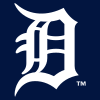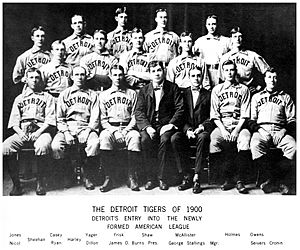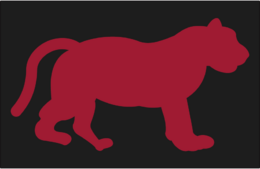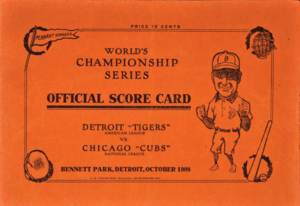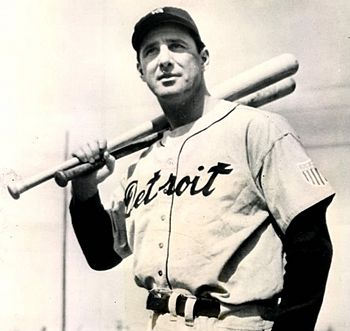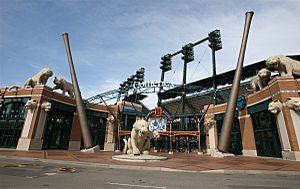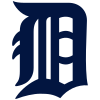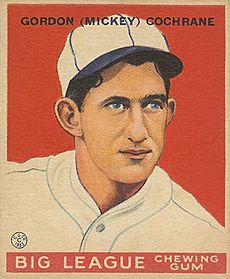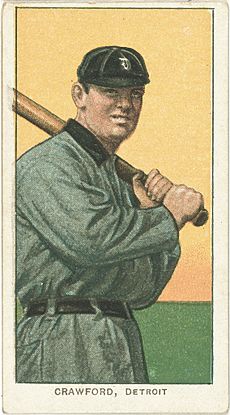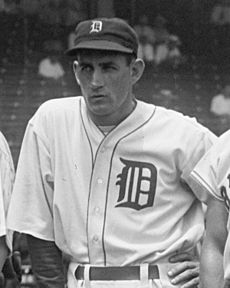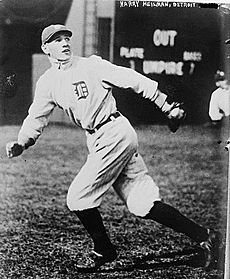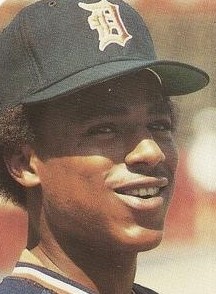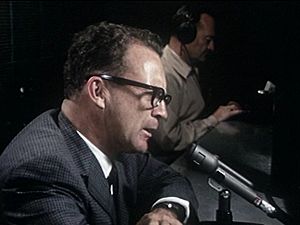Detroit Tigers facts for kids
Quick facts for kids Detroit Tigers |
|||||
|---|---|---|---|---|---|
|
|||||
|
|||||
| Major league affiliations | |||||
|
|||||
| Current uniform | |||||
| Retired numbers | |||||
| Colors | |||||
|
|||||
| Name | |||||
|
|||||
| Other nicknames | |||||
|
|||||
| Ballpark | |||||
|
|||||
| Major league titles | |||||
| World Series titles (4) |
|
||||
| AL Pennants (11) |
|
||||
| AL Central Division titles (4) |
|
||||
| AL East Division titles (3) |
|
||||
| Wild card berths (2) |
|
||||
| Front office | |||||
| Principal owner(s) | Ilitch Holdings | ||||
| President of baseball operations | Scott Harris | ||||
| General manager | Jeff Greenberg | ||||
| Manager | A. J. Hinch | ||||
The Detroit Tigers are a professional baseball team from Detroit, Michigan. They play in Major League Baseball (MLB) as part of the American League (AL) Central Division. The Tigers are one of the original eight teams of the American League. They started in Detroit as a minor league team in 1894. They are the only team from the old Western League still in its first city. They are also the oldest team in the AL to keep the same name and city.
Since becoming a major league team in 1901, the Tigers have won four World Series championships (in 1935, 1945, 1968, and 1984). They have also won 11 AL pennants and four AL Central division titles. They won division titles in 1972, 1984, and 1987 when they were in the American League East. Since 2000, the Tigers have played their home games at Comerica Park in Downtown Detroit.
The Tigers built Bennett Park in 1896. It was at the corner of Michigan Avenue and Trumbull Avenue in Corktown. In 1912, the team moved to Navin Field, built in the same spot. This stadium was expanded and renamed Briggs Stadium in 1938. It became Tiger Stadium in 1961. The Tigers played there until 1999.
From 1901 to 2024, the Tigers' total win-loss record is 9,676 wins and 9,567 losses. Their best winning percentage was in 1934, and their lowest was in 2003.
Contents
- Team History
- Early Years (1894–1900)
- First Major League Season (1901)
- The Ty Cobb Era (1905–1926)
- Breaking Through (1927–1940)
- The War Years (1941–1945)
- A Long Wait (1946–1967)
- World Series Champions (1968)
- A Slow Decline (1973–1978)
- The "Bless You Boys" Era (1979–1987)
- A New Approach (1988–1995)
- Randy Smith Era (1996–2002)
- Most Losses in Team History (2003)
- Rebuilding the Team (2004–2006)
- Falling Short (2007–2010)
- Division Winners (2011–2014)
- Mid-Season Reboot (2015)
- 2016 Season
- Rebuilding Years (2017–2023)
- Return to the Playoffs (2024)
- Best Seasons in Detroit Tigers History
- Worst Seasons in Detroit Tigers History
- Team Payroll Over Time
- Team Nickname
- Team Rivalries
- Fan Base
- Home Attendance
- Team Slogans and Cheers
- Team Uniforms and Logos
- Baseball Hall of Famers
- Award Winners
- Team Roster
- Minor League Teams
- Team Broadcasters
- Team Records
- Team Facilities
- More About the Tigers
- See also
Team History
Early Years (1894–1900)
The team started in 1894 as part of the Western League. They first played at Boulevard Park. In 1895, the owner, George Vanderbeck, built Bennett Park. This park became the team's home for the next 104 seasons. The first game at Bennett Park was on April 13, 1896. The Tigers beat a local team 30–3. They played their first Western League game there on April 28, 1896, winning 17–2.
In 1900, the Western League changed its name to the American League. It was still a minor league then. The next year, it became a major league, competing with the National League.
First Major League Season (1901)
The Tigers became a founding member of the major league American League in 1901. Their first major league game was on April 25, 1901, at Bennett Park. About 10,000 fans watched them win 14–13 against the Milwaukee Brewers. The team finished third in the league that year.
In their first season, they were the first major league team to have a mascot on their cap. It was a red tiger. This was changed to a "D" in 1903. Their famous Old English "D" logo appeared in 1904.
The Ty Cobb Era (1905–1926)
A New Star Arrives (1905)
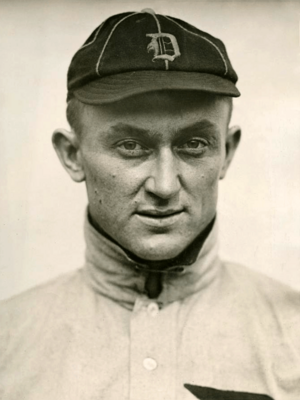
In 1905, the team got Ty Cobb, who was 18 years old. He was a very determined player and became one of the best players ever. With Cobb, and other great players like Sam Crawford, Hughie Jennings, Bill Donovan, and George Mullin, the team quickly got better.
American League Champions (1907)
With strong hitting from Ty Cobb (.350) and Sam Crawford (.323), and great pitching from Bill Donovan and Ed Killian (25 wins each), the Tigers won the AL pennant in 1907. They finished 1.5 games ahead of the Philadelphia Athletics. They then played in their first World Series against the Chicago Cubs.
Game 1 ended in a 3–3 tie. The Tigers scored only three runs in the next four games and lost the Series 4–0.
American League Champions Again (1908)
The Tigers won the AL pennant again in 1908, finishing just half a game ahead of the Cleveland Naps. Cobb hit .324, and Sam Crawford hit .311 with 7 home runs, which was a lot for that time.
The Cubs beat the Tigers again in the 1908 World Series, winning in five games. This was the Cubs' last World Series win until 2016.
Third Straight Pennant (1909)
In 1909, Detroit had a great season, winning the AL pennant by 3.5 games. Ty Cobb won the batting triple crown, leading the league in batting average (.377), home runs (9), and RBIs (107). He also led in stolen bases with 76. George Mullin was a pitching star, winning 29 games.
The Tigers played the Pittsburgh Pirates in the 1909 World Series. The Tigers played better, taking the series to seven games. But they lost the final game 8–0 at Bennett Park.
Ups and Downs (1910–1914)
The Tigers finished third in 1910 and second in 1911. They were behind a very strong Philadelphia Athletics team. In 1912 and 1913, the team finished in sixth place. A highlight in 1912 was George Mullin pitching the team's first no-hitter.
Ty Cobb was suspended in 1912 for an incident with a fan. The Tigers protested by playing a game with replacement players, losing 24–2. During these years, Cobb won the batting title every year.
Close Call (1915)
In 1915, the Tigers won a team record 100 games. But they just missed the AL pennant, losing to the Boston Red Sox, who won 101 games. The 1915 Tigers had a powerful outfield with Ty Cobb, Sam Crawford, and Bobby Veach. They were the top three in RBIs and total bases. Cobb also set a stolen base record with 96 steals.
Later Cobb Years (1916–1926)
The Tigers finished third in 1916. They stayed in the middle of the AL standings for the rest of the decade. Ty Cobb remained the star player, along with Harry Heilmann.
Hughie Jennings left as manager after the 1920 season. He had 1,131 wins, a team record until 1992. Cobb became the manager in 1921. During his six years as manager, the Tigers never won a pennant.
In 1921, the Tigers had a team batting average of .316, the highest in AL history. Harry Heilmann and Ty Cobb were the top two hitters in the AL. But the team's pitching was not good, and they finished sixth.
On August 19, 1921, Cobb got his 3,000th career hit. He was the youngest player to reach this milestone.
The Tigers continued to have good teams under Cobb. Harry Heilmann hit .403 in 1923. Cobb retired in November 1926 after 22 seasons with the Tigers.
Breaking Through (1927–1940)
Building a Strong Team (1927–1933)
After Cobb left, the Tigers had some average seasons. But they were building a strong team. They added slugging first baseman Hank Greenberg and pitchers Tommy Bridges and Schoolboy Rowe. Charlie Gehringer was already on the team.
In 1927, Harry Heilmann almost hit .400, finishing at .398. After the 1933 season, the Tigers got catcher Mickey Cochrane from the Philadelphia Athletics. He became their player-manager.
American League Champions (1934)
The Tigers won the 1934 AL pennant with 101 wins. This was a team record for wins at the time. The Tigers infield (Greenberg, Gehringer, Billy Rogell, and Marv Owen) scored many runs. Schoolboy Rowe led the pitching staff with 24 wins.
The Tigers lost the 1934 World Series in seven games to the St. Louis Cardinals. The Cardinals won the final game 11–0.
World Series Champions (1935)
The 1935 Tigers team had four future Hall of Famers: Hank Greenberg, Mickey Cochrane, Goose Goslin, and Charlie Gehringer. They won the AL pennant by three games over the New York Yankees. Greenberg was named AL MVP. He led the league in home runs (36), and RBIs (168).
The Tigers finally won their first World Series, beating the Chicago Cubs 4–2. Goose Goslin hit a game-winning single in Game 6.
After the owner, Frank Navin, passed away, Walter Briggs Sr. took over the team.
More Strong Seasons (1936–1939)
The Tigers finished second behind the New York Yankees in 1936 and 1937. Hank Greenberg had an exciting season in 1938. He hit 58 home runs, almost breaking Babe Ruth's record of 60.
American League Champions (1940)
In 1940, the Tigers won the AL pennant by one game. Hank Greenberg moved to left field to make room for Rudy York at first base. York hit .316 with 33 home runs. Greenberg batted .340 with 41 home runs and 150 RBIs. Greenberg won his second AL MVP award.
Bobo Newsom was the top pitcher, winning 21 games. Floyd Giebell, a rookie, pitched a 2–0 shutout in the pennant-clinching game.
The Tigers lost the 1940 World Series to the Cincinnati Reds in seven games. This was the third time the Tigers lost a World Series in a deciding Game 7.
The War Years (1941–1945)
With Hank Greenberg serving in World War II, the Tigers struggled. They finished second in 1944. This was thanks to pitchers Hal Newhouser and Dizzy Trout, who won 29 and 27 games. Newhouser won his first of two AL MVP awards that season.
World Series Champions (1945)
With Hank Greenberg returning from the military, the Tigers won the AL pennant in 1945. Newhouser won the pitching triple crown, leading the AL in wins (25), ERA (1.81), and strikeouts (212). He became the only pitcher in AL history to win the MVP Award in two straight seasons.
The Tigers won the 1945 World Series against the Cubs 4–3. Newhouser led the team to a 9–3 victory in Game 7.
A Long Wait (1946–1967)
Post-War Years (1946–1950)
After their 1945 World Series win, the Tigers had winning records but did not win the pennant. Hal Newhouser had another great season in 1946, leading the league in wins (26) and ERA (1.94). The Tigers also got George Kell, a third baseman who became a Hall of Famer. Kell won the batting title in 1949.
The 1950 season was frustrating. The Tigers won 95 games but finished three games behind the New York Yankees.
Struggling Seasons (1951–1960)
Over the next 10 years, the Tigers struggled. They had only three winning records and never finished higher than fourth place. The 1952 team had 50 wins and 104 losses, their worst season until 2003. Despite this, pitcher Virgil Trucks threw two no-hitters in 1952.
Owner Walter Briggs Sr. passed away in 1952. His son, Walter Briggs Jr., sold the team in 1956 to John Fetzer and Fred Knorr.
In 1953, outfielder Al Kaline joined the team. He never played in the minor leagues. In 1955, at 20 years old, Kaline became the youngest batting champion in major league history.
In 1958, the Tigers became the second-to-last team to integrate their roster with Dominican player Ozzie Virgil Sr..
A Strong Improvement (1961)
In 1961, the Tigers improved greatly, winning 101 games. This was a 30-game improvement from 1960. But they still finished eight games behind the Yankees. First baseman Norm Cash won the batting title with a .361 average.
The 1961 team had two non-white starters, Bill Bruton and Jake Wood. Later, black players like Willie Horton and Earl Wilson helped the team rise.
Building a Core (1962–1966)

The Tigers had winning records throughout the 1960s. In 1963, pitchers Mickey Lolich and Denny McLain joined the team. Outfielders Willie Horton, Mickey Stanley, and Jim Northrup also joined around this time.
The team finished third in 1966. After the season, Mayo Smith became the new manager.
A Close Pennant Race (1967)
In 1967, the Tigers were in a very close pennant race. They finished one game behind the Boston Red Sox. Pitcher Earl Wilson led the team with 22 wins. He formed a strong pitching group with Denny McLain and Mickey Lolich.
World Series Champions (1968)
Glory in '68
The Tigers returned to the World Series in 1968. They took first place in May and stayed there, finishing with 103 wins. Pitcher Denny McLain won 31 games, the first time a pitcher had done that since 1934. McLain won the AL MVP and Cy Young Award.
1968 World Series
In the 1968 World Series, the Tigers played the St. Louis Cardinals. The Cardinals had pitcher Bob Gibson, who had a very low ERA of 1.12. Manager Mayo Smith made a bold move, playing center fielder Mickey Stanley at shortstop. This allowed him to play Willie Horton, Jim Northrup, and Al Kaline in the outfield.
In Game 1, Gibson struck out 17 batters, a World Series record, as the Cardinals won 4–0. But Mickey Lolich won Games 2 and 5, helping the Tigers get back into the series. A key moment was in Game 5 when Willie Horton threw out Lou Brock at home plate. The Tigers won that game 5–3. In Game 6, McLain won 13–1, forcing a Game 7.
In Game 7, Lolich faced Gibson. Both pitched very well. In the seventh inning, Jim Northrup hit a triple that scored two runs. Bill Freehan then doubled to score Northrup. The Tigers won 4–1, winning the World Series 4–3.
The Tigers became only the third team to win the World Series after being down 3–1. Lolich was named the World Series Most Valuable Player.
After the Championship (1969–1971)
In 1969, the Tigers were placed in the American League East. They finished second in their division, even though Denny McLain had another great season with 24 wins.
The Tigers had a disappointing 1970 season. Mayo Smith was replaced by Billy Martin as manager. The Tigers also traded Denny McLain to the Washington Senators. They got pitcher Joe Coleman, shortstop Eddie Brinkman, and third baseman Aurelio Rodríguez.
Martin's Tigers won 91 games in 1971. Mickey Lolich had 308 strikeouts, a team record. Coleman won 20 games.
AL East Champions (1972)
Coleman, Brinkman, and Rodríguez were key players in 1972. The Tigers won their first AL East division title. Brinkman was named Tiger of the Year for his great defense. Mickey Lolich won 22 games, and Coleman won 19. Pitcher Woodie Fryman joined the team in August and helped them win the division.
1972 ALCS
In the 1972 American League Championship Series, Detroit played the Oakland Athletics. The A's won Game 1 in extra innings. In Game 2, the A's won 5–0. An incident occurred when Tigers pitcher Lerrin LaGrow hit A's shortstop Bert Campaneris with a pitch. Both players were suspended for the rest of the series.
The series moved to Detroit. Joe Coleman pitched a shutout in Game 3, winning 3–0. Game 4 was another close game. The Tigers won 4–3 in the 10th inning.
In Game 5, the A's took a 2–1 lead. A controversial call at first base helped the A's score. The A's won the game and the AL pennant.
A Slow Decline (1973–1978)
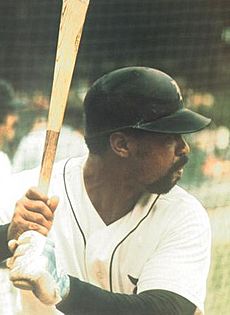
In 1973, the Tigers finished third. Joe Coleman won 23 games. Billy Martin was fired as manager in September. John Hiller, a relief pitcher, had a great season with 38 saves.
After the season, Ralph Houk became the new manager. The Tigers did not have a winning season from 1974 to 1977. Al Kaline retired in 1974 after getting his 3,000th career hit. He was elected to the Hall of Fame in 1980.
The Year of The Bird (1976)
In 1976, rookie pitcher Mark Fidrych, known as "The Bird," became very popular. He was known for talking to the baseball. Fidrych finished the season with 19 wins and an AL-leading ERA of 2.34. He won the AL Rookie of the Year award.
Aurelio Rodríguez won the Gold Glove Award at third base in 1976.
New Talent Arrives (1977–1978)
Injuries limited Fidrych's playing time in 1977–78. But new talent was coming up. Jack Morris, Lance Parrish, Alan Trammell, and Lou Whitaker all made their debuts in 1977. They helped the team win 88 games in 1978, their only winning season under Houk.
The "Bless You Boys" Era (1979–1987)
George "Sparky" Anderson became the Tigers' manager in 1979. He had won two World Series with the Cincinnati Reds. Anderson predicted the team would win a pennant within five years.
World Series Champions (1984)
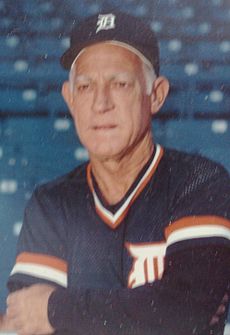
The 1984 Tigers started the season with a 9–0 record. Jack Morris pitched a no-hitter in the fourth game. They won 35 of their first 40 games and finished with a team-record 104 wins. They led their division from the first day of the season. Closer Willie Hernández won both the Cy Young Award and AL MVP.
1984 ALCS
The Tigers played the Kansas City Royals in the American League Championship Series. The Tigers won Game 1 easily. In Game 2, they scored two runs in the 11th inning to win 5–3. The Tigers completed the sweep in Game 3, winning 1–0. They were going to the World Series.
1984 World Series
The Tigers played the San Diego Padres in the 1984 World Series. The Tigers won Game 1. The Padres won Game 2.
When the series moved to Detroit, the Tigers took control. They won Game 3 and Game 4. Alan Trammell hit two home runs in Game 4.
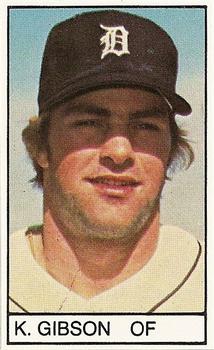
In Game 5, Kirk Gibson hit a two-run home run early in the game. The Padres tied the game, but the Tigers took the lead again. Gibson came up to bat in the eighth inning with runners on base. He hit a three-run home run into the upper deck, which sealed the win.
Aurelio López pitched well in relief. Willie Hernández got the final out, and the Tigers won the World Series 4–1.
The Tigers led their division from the first day of the season until winning the World Series. Sparky Anderson became the first manager to win the World Series in both the American and National Leagues.
AL East Champions (1987)
After finishing third in 1985 and 1986, the 1987 Tigers started slowly. But they improved and gained on their rivals. Pitcher Doyle Alexander was a key addition, winning 9 games without a loss. The Tigers battled the Toronto Blue Jays in a close race.
Detroit clinched the division with a 1–0 victory over Toronto on October 4. Frank Tanana pitched a complete game shutout. The Tigers finished with the best record in the majors (98–64).
In their last postseason appearance until 2006, the Tigers lost to the Minnesota Twins 4–1 in the 1987 American League Championship Series.
A New Approach (1988–1995)
The Tigers finished second in 1988. In 1989, the team had a very bad season, winning only 59 games. The team tried to rebuild with power hitters like Cecil Fielder, Rob Deer, and Mickey Tettleton. In 1990, Fielder led the AL with 51 home runs.
The Tigers improved in 1990 and had a winning record in 1991. But they lacked good pitching. In August 1992, the team was sold to Mike Ilitch. One of Ilitch's first moves was to rehire announcer Ernie Harwell. Sparky Anderson became the winningest manager in Tigers history in 1992.
On October 2, 1995, manager Sparky Anderson retired from baseball.
Randy Smith Era (1996–2002)
From 1994 to 2005, the Tigers did not have a winning record. In 1996, they lost 109 games. In 1998, the Tigers moved from the AL East to the AL Central division.
In 2000, the team moved from Tiger Stadium to Comerica Park. The new park was criticized for its deep outfield, which made it hard to hit home runs. In 2003, the team moved the left-center field fence closer.
In late 2001, Dave Dombrowski was hired as team president. In 2002, the Tigers started 0–6. Dombrowski fired general manager Randy Smith and manager Phil Garner. The team finished 55–106.
Most Losses in Team History (2003)
Dave Dombrowski hired former shortstop Alan Trammell to manage the team in 2003. The Tigers finished with 43 wins and 119 losses, the worst record in team history. This was the fourth worst record in major league history.
Mike Maroth lost 20 games, becoming the first pitcher to do so since 1980.
Rebuilding the Team (2004–2006)
After the 2003 season, the Tigers made changes. They signed new players like Iván Rodríguez and Carlos Guillén. The 2004 Tigers finished 72–90, a 29-game improvement.
In 2005, the Tigers signed Troy Percival and Magglio Ordóñez. They hosted the Major League Baseball All-Star Game. The team finished 71–91. Trammell was fired as manager.
In October 2005, Jim Leyland became the new manager. Pitcher Kenny Rogers also joined the team.
Return to the American League Championship (2006)
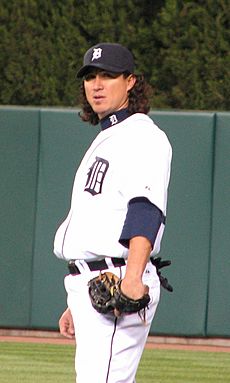
The 2006 season brought hope. Rookies like Justin Verlander, Curtis Granderson, and Joel Zumaya played well. The team quickly rose to the top of the AL Central. On September 24, the Tigers clinched their first playoff spot since 1987. They finished 95–67, winning the AL wild card.
In the playoffs, the Tigers beat the New York Yankees 3–1. They then swept the Oakland Athletics in the ALCS, with Magglio Ordóñez hitting a game-winning home run in Game 4. They reached the World Series but lost to the St. Louis Cardinals in five games.
Falling Short (2007–2010)

2007 Season
In 2007, the Tigers traded for outfielder Gary Sheffield. On June 12, Verlander pitched the Tigers' first no-hitter since 1984. The Tigers had the best record in baseball in July but then struggled. They finished second in the AL Central with 88 wins.
Magglio Ordóñez won the AL batting title in 2007 with a .363 average.
2008 Season

In 2008, the Tigers traded for Miguel Cabrera and Dontrelle Willis. The team had a high payroll but started by losing seven straight games. They finished with a 74–88 record. Justin Verlander had a tough season. Despite the losses, the team set an attendance record.
2009 Season
In 2009, the Tigers got pitcher Edwin Jackson and rookie Rick Porcello. Justin Verlander had a strong season, winning 19 games. Fernando Rodney became the closer, getting 37 saves.
The Tigers had a 7-game lead in their division in September. But they lost it and ended up tied with the Minnesota Twins on the last day. They lost the tie-breaker game, finishing 86–77.
2010 Season

In 2010, the Tigers traded Curtis Granderson and Edwin Jackson. They got Austin Jackson and pitchers Max Scherzer and Phil Coke. Jackson and Brennan Boesch had good rookie seasons.
The Tigers were close to first place at the All-Star break. But injuries caused them to struggle. They finished third with an 81–81 record. Miguel Cabrera had a great season, hitting .328 with 38 home runs and 126 RBIs.
The Near-Perfect Game
On June 2, 2010, Armando Galarraga was pitching a perfect game. With two outs in the ninth inning, the first-base umpire made a wrong call, ruling a runner safe. Video replays showed the runner was out. The umpire later apologized to Galarraga.
Division Winners (2011–2014)
First AL Central Championship (2011)
The Tigers kept most of their 2010 team and added Victor Martinez and Brad Penny. On May 7, Verlander pitched his second career no-hitter. On August 27, he became the first Tiger since 1991 to win 20 games.
The Tigers were behind in May but started playing better. They sent five players to the 2011 All-Star Game.
The Tigers had a 12-game winning streak in September. On September 16, they won the AL Central Division title. This was their first division title since 1987.
Justin Verlander won the pitching triple crown, leading the AL in wins (24), ERA (2.40), and strikeouts (250). He won the AL Cy Young Award and AL MVP. José Valverde led the AL with 49 saves. Miguel Cabrera won the AL batting title with a .344 average.
The Tigers beat the New York Yankees 3–2 in the ALDS. They lost to the Texas Rangers 4–2 in the ALCS.
American League Champions (2012)
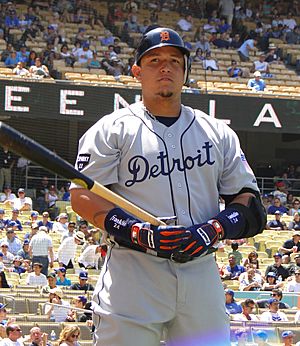
In 2012, the Tigers signed Prince Fielder to a large contract. Miguel Cabrera moved to third base. The Tigers also got Omar Infante and Aníbal Sánchez in a trade.
The Tigers started slowly but played much better in the second half. They clinched the AL Central division title on October 1. This was their first time winning back-to-back division titles.
On the last day of the season, Cabrera won the Triple Crown, leading the AL in batting average (.330), home runs (44), and RBIs (139). Justin Verlander and Max Scherzer were the top two in AL strikeouts.
In the ALDS, the Tigers beat the Oakland Athletics 3–2. They then swept the New York Yankees in the ALCS to win their 11th AL pennant. In the World Series, the Tigers were swept by the San Francisco Giants.
Cabrera was named AL MVP on November 15, 2012.
American League Title Defense (2013)
The Tigers aimed to defend their AL pennant in 2013. They signed Torii Hunter and Aníbal Sánchez. Justin Verlander signed a large contract extension. Six Tigers players were on the 2013 American League All-Star team.
On September 25, the Tigers won their third straight AL Central Division title. Tigers pitchers set a record with 1,428 strikeouts. Cabrera won his second straight AL MVP award. Scherzer won the AL Cy Young Award.
The Tigers beat the Oakland Athletics 3–2 in the ALDS. They advanced to their third straight ALCS, where they lost to the Boston Red Sox in six games.
Changes at the Top (2014)

Jim Leyland stepped down as manager. The Tigers hired Brad Ausmus as his replacement. The Tigers traded Prince Fielder for Ian Kinsler. They also traded Doug Fister for other players.
The Tigers tried to improve their bullpen. They signed Joe Nathan and Joba Chamberlain. They also traded for Joakim Soria and David Price. With Price, the Tigers became the first team with three straight Cy Young Award winners in their starting rotation.
On September 28, the Tigers won their fourth straight AL Central Division title. They finished one game ahead of the Kansas City Royals.
The Tigers played the Baltimore Orioles in the 2014 American League Division Series. They were swept 3–0.
Mid-Season Reboot (2015)
Brad Ausmus continued as manager. Max Scherzer and Torii Hunter left the team. The Tigers traded for Yoenis Céspedes, Alex Wilson, and other players.
The season started well but then went downhill. Injuries to key players like Joe Nathan, Victor Martínez, Justin Verlander, and Miguel Cabrera hurt the team. The Tigers decided to "reboot" the team. They traded David Price, Joakim Soria, and Cespedes for six young prospects.
On August 4, longtime general manager Dave Dombrowski was replaced by Al Avila.
The Tigers sent four players to the 2015 MLB All-Star Game. They finished last in their division with a 74–87 record. Their pitching was among the worst, but their batting average was the best in MLB. Miguel Cabrera won his fourth batting title.
2016 Season
The Tigers made more changes for 2016. They added pitchers Jordan Zimmermann and Francisco Rodriguez, and outfielder Justin Upton.
The Tigers finished the season with 86 wins and 75 losses. They were eight games behind the Cleveland Indians. They were the last team to be eliminated from wild card contention.
Pitcher Michael Fulmer won the 2016 AL Rookie of the Year Award.
Rebuilding Years (2017–2023)
2017 Season
Mike Ilitch, the Tigers owner, passed away in 2017. His son, Christopher Ilitch, took over. The team began a rebuild, trading J. D. Martinez, Alex Avila, Justin Upton, and Justin Verlander.
On September 22, the Tigers announced that manager Brad Ausmus' contract would not be extended. The Tigers finished the season tied for the worst record in MLB. They earned the number one pick in the 2018 MLB Draft.
2018 Season
On October 20, 2017, Ron Gardenhire became the new manager. The team continued rebuilding with young players. Miguel Cabrera and Michael Fulmer had long stints on the disabled list. The team finished with the same 64–98 record as the previous year.
2019 Season
Michael Fulmer missed the 2019 season due to surgery. The Tigers finished with 47 wins and 114 losses, their second worst season ever. They had the worst record in Major League Baseball.
2020 Season
On April 6, Al Kaline passed away. The Tigers wore a No. 6 patch to honor him. In the shortened 60-game season due to the COVID-19 pandemic, the Tigers were in playoff contention for a while. Manager Ron Gardenhire retired in September. The Tigers finished with 23 wins and 35 losses.
2021 Season
On October 30, 2020, the Tigers hired A. J. Hinch as manager. On May 18, 2021, Spencer Turnbull pitched the eighth no-hitter in Tigers history. The Tigers finished the season with 77 wins and 85 losses, better than expected.
2022 Season
On August 10, 2022, Al Avila was fired as general manager. On September 19, 2022, Scott Harris was hired as president of baseball operations. The Tigers finished with 66 wins and 96 losses. On October 25, 2022, Rob Metzler was hired as assistant general manager.
2023 Season
On September 21, 2023, Jeff Greenberg was hired as general manager. The Tigers finished with 78 wins and 84 losses, in second place in their division. This was the final season for long-time slugger Miguel Cabrera, who then joined the Tigers' front office.
Return to the Playoffs (2024)
2024 Season
The 2024 season was expected to be quiet. But the Tigers played very well late in the season, winning 31 of their last 42 games. They clinched a playoff spot on September 27, their first since 2014. They finished the season with 86 wins and 76 losses.
In the American League Wild Card Series, the Tigers swept the Houston Astros 2–0. This was their first postseason series win since 2013. In the American League Division Series, the Tigers lost to the Cleveland Guardians in five games.
Best Seasons in Detroit Tigers History
|
|||||||||||||||||||||||||||||||||||||||||||||||||||||||||||||||||||||||||
Worst Seasons in Detroit Tigers History
|
|||||||||||||||||||||||||||||||||||||||||||||||||||||||||||||
Team Payroll Over Time
|
|||||||||||||||||||||||||||||||||||
Team Nickname
The team was called the Wolverines and Creams in 1894 before becoming the Tigers. There are different stories about how they got their nickname. One story says it was because of their striped socks. Another story says it came from a military unit called "The Tigers." This unit played important roles in wars. When the baseball team joined the major leagues, they asked for permission to use the name.
Team Rivalries
The Tigers have developed strong rivalries, especially in the 21st century playoffs. Their games against the New York Yankees in 2006, 2011, and 2012 were very exciting. The Tigers won each of those series. These matchups made the rivalry even stronger.
Their 2024 playoff series against the Cleveland Guardians also added to the rivalry. The Guardians won a close five-game series. But the Tigers' sweep of the Houston Astros in the Wild Card Series brought a lot of excitement to their fans.
Chicago White Sox
The rivalry between the Tigers and the Chicago White Sox is one of the oldest in baseball. Both teams joined the American League in 1901. They have played each other every year for over 120 seasons. Like other sports teams in Chicago and Detroit, there is a natural rivalry. Even though they have played over 2,200 games, they have not yet met in the postseason.
Divisional Rivals
The Tigers also have rivalries with the Cleveland Guardians, the Kansas City Royals, and the Minnesota Twins. The rivalry with Cleveland became very intense in 2013. During a game in Cleveland, Tigers fans chanted "Let's go Tigers!" Cleveland fans responded with a chant about Detroit's financial situation. The Tigers won that game in extra innings. The teams met in the postseason for the first time in the 2024 American League Division Series, with Cleveland winning the series.
Other Rivalries
The Tigers also have a rivalry with the Toronto Blue Jays from when they were in the same division. They also have rivalries with National League teams they have played in the World Series, like the Chicago Cubs (four times) and St. Louis Cardinals (three times). In games against teams from the other league, the Pittsburgh Pirates are considered the Tigers' "natural rival."
Fan Base
The Tigers have many fans around the Lake Erie region. This includes Michigan, northwestern Ohio, and southwestern Ontario. There is also a small fan base near Erie, Pennsylvania. This is because Detroit is close to these areas. Also, the Tigers' minor league teams, the Erie SeaWolves and Toledo Mud Hens, are in these areas. Many baseball fans in southwestern Ontario are loyal Tigers fans.
Home Attendance
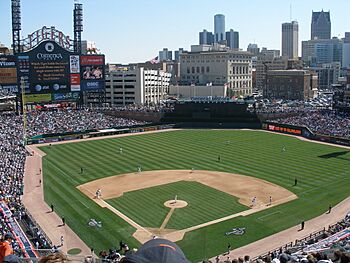
Comerica Park Attendance
| Home Attendance at Comerica Park | ||||
| Year | Total Attendance | Game Average | League Rank | |
| 2000 | 2,438,617 | 30,106 | 7th | |
| 2001 | 1,921,305 | 23,720 | 9th | |
| 2002 | 1,503,623 | 18,795 | 12th | |
| 2003 | 1,368,245 | 16,892 | 13th | |
| 2004 | 1,917,004 | 23,667 | 9th | |
| 2005 | 2,024,431 | 24,993 | 10th | |
| 2006 | 2,595,937 | 32,049 | 5th | |
| 2007 | 3,047,133 | 32,719 | 3rd | |
| 2008 | 3,202,645 | 39,539 | 3rd | |
| 2009 | 2,567,165 | 31,693 | 4th | |
| 2010 | 2,461,237 | 30,386 | 6th | |
| 2011 | 2,642,045 | 32,618 | 6th | |
| 2012 | 3,028,033 | 37,383 | 5th | |
| 2013 | 3,083,397 | 38,067 | 3rd | |
| 2014 | 2,917,209 | 36,015 | 4th | |
| 2015 | 2,726,048 | 33,655 | 5th | |
| 2016 | 2,493,859 | 31,173 | 7th | |
| 2017 | 2,321,599 | 28,662 | 7th | |
| 2018 | 1,856,970 | 22,926 | 10th | |
| 2019 | 1,501,430 | 18,536 | 12th | |
| 2020 | N/A (COVID-19 pandemic) | N/A | N/A | |
| 2021 | 1,102,623 | 13,612 | 11th | |
| 2022 | 1,575,544 | 19,214 | 10th | |
| 2023 | 1,612,876 | 19,912 | 12th | |
| 2024 | 1,858,295 | 22,942 | 11th | |
Team Slogans and Cheers
During the 1968 season, the cheer "Go Get 'Em, Tigers" was popular. It came from a song. "Sock it to 'em, Tigers!" was also a common phrase.
In the 1984 World Series, the team was cheered on with "Bless You Boys." This phrase was created by sportscaster Al Ackerman.
In 2005, the team started using "Who's Your Tiger?" as its slogan.
During the 2006 season, "Gum Time" became a popular rally cry. It started when pitcher Nate Robertson was seen stuffing bubble gum into his mouth during a game.
A local man named James Van Horn was known for yelling "Eat 'Em Up Tigers! Eat 'Em Up!" around Comerica Park.
In 2009, the slogan was "Always a Tiger." In 2011, it went back to "Who's Your Tiger?"
In 2018, "Rally Goose" became a popular cheer. A goose appeared on the field during a rain delay. After it left, the Tigers scored many runs and won the game.
Team Uniforms and Logos
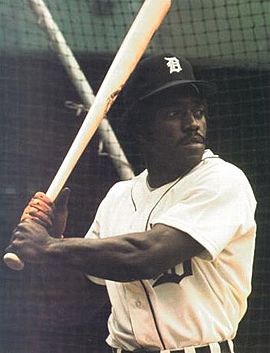
The Tigers have worn mostly the same home uniform since 1934. It's a white jersey with navy blue trim and an Old English "D" on the left chest. They wear white pants and a navy blue hat with a white "D". On their road uniforms, the "D" on the hat is orange, and "Detroit" is written across the jersey.
The current road uniform design started in 1994. Before that, they had different styles. The Old English "D" first appeared on Tigers uniforms in 1904. In 1960, the Tigers briefly changed their uniform to say "Tigers" in script, but they went back to the traditional look after one season.
In 2018, the Tigers changed the "D" on their home uniforms to match the sharper "D" on their hats. In 2019, they went back to a smaller "D" on the cap but kept the sharper "D" on the home jerseys.
In 2023, the Tigers added a uniform sponsorship patch for Meijer, a store chain. The patch is navy blue on white for home games and white on black with an orange outline for road games.
Unique features of the Tigers uniforms:
- The Tigers are the only MLB team to have a color (orange) on their road uniforms that is not on their home uniforms.
- The Tigers' uniform pants have more belt loops than other teams.
Alternate Jerseys: In 1995, the Tigers had a navy blue alternate jersey with a tiger logo. They wore it for one home game.
The Tigers wear throwback jerseys of the Detroit Stars for their annual Negro Leagues Tribute Game. This honors players from the Negro leagues.
They also wear a white and navy blue home jersey with "Tigres" across the chest for their annual "¡Fiesta Tigres!" game. This celebrates Hispanic and Latino players.
For Players Weekend, the Tigers wore special stylized jerseys. In 2017, their away jerseys were grey with bright orange. In 2018, they wore blue jerseys with orange sleeves. Players often used nicknames on their jerseys.
In 2024, the Tigers introduced their first City Connect jersey. It celebrates Detroit's automobile industry. The jersey is navy blue with electric blue tire patterns and says "Motor City" on the front. It also has racing stripes. The sleeve patch has a "D" logo and refers to Woodward Avenue, a famous road in Detroit. The cap has "Detroit" on the front and a special tag with numbers referencing the team's first AL season (1901) and World Series wins.
Baseball Hall of Famers
| Detroit Tigers Hall of Famers | |||||||||
|---|---|---|---|---|---|---|---|---|---|
| Affiliation according to the National Baseball Hall of Fame and Museum | |||||||||
|
Ford C. Frick Award Recipients
| Detroit Tigers Ford C. Frick Award recipients | |||||||||
|---|---|---|---|---|---|---|---|---|---|
| Affiliation according to the National Baseball Hall of Fame and Museum | |||||||||
|
Michigan Sports Hall of Fame Members
| Detroit Tigers in the Michigan Sports Hall of Fame | ||||
| No. | Name | Position | Tenure | Notes |
|---|---|---|---|---|
| — | Frank Navin | Owner | 1908–1935 | Born in Adrian. |
| — | Walter Briggs Sr. | Owner | 1919–1935 | Born in Ypsilanti. |
| — | John Fetzer | Owner | 1961–1983 | |
| — | Mike Ilitch | Owner | 1992–2017 | Born and raised in Detroit. |
| — | Marian Ilitch | Owner | 1992 | Born and raised in Dearborn. |
| — | Jim Campbell | Executive | 1962–1983 1978–1990 1990–1992 |
|
| — | Ty Tyson | Broadcaster | 1927-1942 | |
| — | Paul Carey | Broadcaster | 1973–1991 | Born and raised in Mount Pleasant. |
| — | Ernie Harwell | Broadcaster | 1960–1991 1993–2002 |
|
| — | Van Patrick | Broadcaster | 1949, 1952–1959 | |
| — | Ray Lane | Broadcaster | 1967–1972, 1999-2003 | |
| — | Frank Beckmann | Broadcaster | 1995-2003 | |
| — | Ty Cobb | CF Manager |
1905–1926 1921–1926 |
|
| — | Sam Crawford | OF | 1903–1917 | |
| — | Wish Egan | P | 1902 | Born and raised in Evart. |
| — | Harry Heilmann | RF/1B Broadcaster |
1914 1916–1929 |
|
| — | Hughie Jennings | IF Manager |
1907, 1909–1910, 1912, 1918 1907–1920 |
|
| — | Heinie Manush | LF | 1923–1927 | |
| — | George Mullin | P | 1902–1913 | |
| 1 | Lou Whitaker | 2B | 1977–1995 | |
| 2 | Charlie Gehringer | 2B GM |
1924–1942 1951–1953 |
Grew up near Fowlerville. Attended the University of Michigan. |
| 3 | Mickey Cochrane | C Manager |
1934–1937 1934–1938 |
|
| 3 | Dick McAuliffe | 2B/SS | 1960–1973 | |
| 3 | Alan Trammell | SS Coach Manager |
1977–1996 1999 2003–2005 |
|
| 4 | Goose Goslin | LF | 1934–1937 | |
| 4 | Rudy York | 1B | 1934, 1937–1945 | |
| 4 | Charlie Maxwell | LF | 1955–1962 | Born in Lawton. Attended Western Michigan University. |
| 5 | Hank Greenberg | 1B | 1930, 1933–1941 1945–1946 |
|
| 5, 20 | Vic Wertz | RF/1B | 1947–1952 1961–1963 |
|
| 5 | Jim Northrup | OF | 1964–1974 | Born in Breckenridge. Attended Alma College. |
| 6 | Al Kaline | RF Broadcaster |
1953–1974 | |
| 7 | Billy Rogell | SS | 1930–1939 | |
| 7, 26 | Harvey Kuenn | OF/SS | 1952–1959 | |
| 7 | Rick Leach | OF/1B | 1981–1983 | Born in Ann Arbor. Attended the University of Michigan. |
| 10 | Tommy Bridges | P | 1930–1943 1945–1946 |
|
| 10 | Jim Leyland | Manager | 2006–2013 | |
| 11 | Sparky Anderson | Manager | 1979–1995 | |
| 11 | Bill Freehan | C | 1961, 1963–1976 | Born and raised in Detroit. Attended the University of Michigan. |
| 13 | Lance Parrish | C | 1977–1986 | |
| 14 | Schoolboy Rowe | P | 1933–1942 | |
| 14, 15 | Jim Bunning | P | 1955–1963 | Elected mainly for his performance with Philadelphia Phillies. |
| 15, 21 | George Kell | 3B Broadcaster |
1946–1952 1959–1963 1965–1996 |
|
| 16 | Hal Newhouser | P | 1939–1953 | Born and raised in Detroit. |
| 17 | Denny McLain | P | 1963–1970 | |
| 18 | John Hiller | P | 1965–1970 1972–1980 |
|
| 20 | Billy Pierce | P | 1945, 1948 | Elected mainly for his performance with Chicago White Sox. Born in Detroit and grew up in Highland Park. |
| 21 | Barney McCosky | OF | 1939–1942, 1946 | Grew up in Detroit. |
| 21, 30 | Don Lund | OF | 1949, 1952–1954 | Born and raised in Detroit. Attended the University of Michigan. |
| 21 | Willie Hernández | P | 1984–1989 | |
| 22 | Virgil Trucks | P | 1941–1952, 1956 | |
| 23 | Willie Horton | LF/DH | 1963–1977 | Born and raised in Detroit. Attended Detroit Northwestern High School. |
| 23 | Kirk Gibson | OF Coach Broadcaster |
1979–1987 1993–1995 2003–2005 |
Born in Pontiac. Grew up in Waterford and attended Michigan State University. |
| 24 | Mickey Stanley | CF | 1964–1978 | Grew up in Grand Rapids. |
| 25 | Norm Cash | 1B Broadcaster |
1960–1974 | |
| 26 | Gates Brown | LF Coach |
1963–1975 1978–1984 |
|
| 26 | Frank Tanana | P | 1985–1992 | Grew up in Detroit. |
| 29 | Mickey Lolich | P | 1963–1975 | |
| 47 | Jack Morris | P Broadcaster |
1977–1990 | |
Retired Numbers and Honorees
The Tigers honor their retired numbers and special names on the outfield walls at Comerica Park.
In left field:
|
In right field:
|
- Ty Cobb, Harry Heilmann, Heinie Manush, Hughie Jennings, and Sam Crawford are honored with their names on the wall. They played before numbers were worn on jerseys.
- The names of Mickey Cochrane and George Kell are also displayed to honor them.
- Al Kaline was also a TV commentator for the Tigers. George Kell was a radio announcer.
- Ernie Harwell was a Tigers radio and TV announcer for 42 years.
- Jackie Robinson's No. 42 was retired across all of Major League Baseball in 1997.
Most players with retired numbers (and Ty Cobb) also have statues behind their names at Comerica Park.
A street near the old Tiger Stadium was renamed Cochrane Street for Mickey Cochrane. Another street was renamed Kaline Drive for Al Kaline.
The most recent number retired by the Tigers was Jim Leyland's No. 10 on August 3, 2024.
Team Captains
- Bill Coughlin 1907–1908
- Germany Schaefer 1907–1909
- George Moriarty 1911–1916
- Brad Ausmus 1999
- Doug Brocail 1999
- Dean Palmer 1999
Award Winners
Team Roster
|
Detroit Tigers 2023 spring training roster
|
||||||
|---|---|---|---|---|---|---|
| 40-man roster | Non-roster invitees | Coaches/Other | ||||
|
Pitchers
|
Catchers
Infielders
Outfielders
|
|
Manager
Coaches
40 active, 0 inactive, 0 non-roster invitees
|
|||
Minor League Teams
The Detroit Tigers have seven minor league teams.
| Class | Team | League | Location | Ballpark | Affiliated |
|---|---|---|---|---|---|
| Triple-A | Toledo Mud Hens | International League | Toledo, Ohio | Fifth Third Field | 1987 |
| Double-A | Erie SeaWolves | Eastern League | Erie, Pennsylvania | UPMC Park | 2001 |
| High-A | West Michigan Whitecaps | Midwest League | Comstock Park, Michigan | LMCU Ballpark | 1997 |
| Single-A | Lakeland Flying Tigers | Florida State League | Lakeland, Florida | Publix Field at Joker Marchant Stadium | 1963 |
| Rookie | FCL Tigers | Florida Complex League | 1995 | ||
| DSL Tigers 1 | Dominican Summer League | San Pedro de Macorís, San Pedro de Macorís | Detroit Tigers Academy | 1992 | |
| DSL Tigers 2 | 2022 |
Team Broadcasters
Radio Broadcasts
The Tigers' main radio station is WXYT-FM (97.1 FM). Dan Dickerson does the play-by-play. Bobby Scales, Dan Petry, and Andy Dirks take turns doing the color commentary. When Dan Dickerson is working on TV, Greg Gania fills in. Games are broadcast throughout Michigan and parts of Ohio.
Television Broadcasts
Since 2025, FanDuel Sports Network Detroit has been the Tigers' local TV channel. They started broadcasting Tigers games in 1998.
The Tigers' TV team includes Jason Benetti for play-by-play. Former Tigers players Andy Dirks, Dan Petry, Todd Jones, and Carlos Peña provide color commentary. Dan Dickerson also fills in for TV broadcasts sometimes.
Former Broadcasters
Team Records
Team Facilities
The team has a training center in the Dominican Republic.
More About the Tigers
- List of Detroit Tigers seasons
- Detroit Tigers all-time roster
- List of Detroit Tigers owners and executives
See also
 In Spanish: Detroit Tigers para niños
In Spanish: Detroit Tigers para niños



